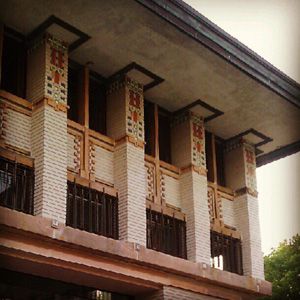
Prairie School and the Decorative Arts
We’ve recently seen some beautiful examples of Prairie School design cross our path. When thinking of the phrase “Prairie School,” we generally think of Frank Lloyd Wright and architecture. Although Wright is one of the most famous names in Prairie School design, the movement also encompasses an aesthetic that extends to the decorative arts.

The term Prairie School is specific to a time period (the late 19th century and early 20th century) as well as a design aesthetic. The Prairie School movement was inspired in part by the newness of the West, where the vast expanses of untouched land encouraged a sense of freshness and innovation. Young designers and architects desired a uniquely American aesthetic, independent of the traditional European classical architecture. Rather than looking to the Greeks and Romans for inspiration, the artists looked to the land itself, echoing the horizontal lines of the native prairie landscape.
The Prairie School emerged in part from the ideals of the English Arts & Crafts movement and its emphasis on a dedication to craftsmanship, quality materials and a disciplined approach to ornament (often concentrating on abstracted naturalistic forms). The lamp pictured below is a particularly eye-catching piece from the noted manufacturer Bradley & Hubbard.

The lamp is a lovely example of the Prairie School movement’s approach to decorative arts. The strong horizontal lines of the shade provide a framework for panels of green and ruby red slag glass panels. The hexagonal base is accented with an engraved design echoing the lines of the shade. The rhythmic abstracted geometric design and overall simplicity are evocative of Wright’s theory that lack of ostentatious ornamentation only serves to emphasize the beauty of the materials.

The sterling silver dish and underplate pictured above are from the Chicago silversmith Kalo, which was founded in 1900 by Clara P. Barck as one of the earliest silversmithing enterprises in the city. Barck was a vocal advocate of women’s involvement in the Arts & Crafts movement, and employed both men and women as professional artisans. The Kalo silversmiths were influenced by both the Arts & Crafts movement and the Prairie School movement. Pieces like the napkin ring below are a nice example of the marrying of the two styles; the bold and modern geometric shape is hand-hammered, decorated only with an applied monogram.

